What are the economic impacts of racism and anti-racism on all of us? Heather McGhee, an African American economist, provides a compelling perspective in her book, The Sum of Us: What Racism Costs Everyone and How We Can Prosper Together. McGhee notes that many people who are biased see our society as a “zero-sum game”—they assume if Blacks get to “win,” Whites must lose. She explores whether this assumption is supported by the data.
The author starts with a description of the community swimming pools built in the 1950s and 1960s. Built to rival the best resorts, some of these public pool complexes could hold thousands of people at once. In the days before air conditioning, children and adults filled the pools to cool off. There were more than 2000 of these pools across the U.S. However, most were for Whites only. In the 1960s, Blacks sued to open them to all people. They won. The response of the vast majority of the cities was to close the pools down. As a result of this racism, everyone lost.
How racism affected public college for all students
Another example is the reduction of public support for college. After WWII, the GI Bill allowed thousands of mostly White veterans to attend school at no cost and get degrees. PELL grants followed for the next generation. State legislatures invested massive amounts of money in public colleges such as SUNY and the University of California. But as more Blacks attended college, legislators cut back on financial aid and support for education. Today, as a result of this racism, all but the wealthiest students—both Black and White—have massive amounts of debt. The author goes on to show other ways in which (usually lower income) Whites are hurt by racism against Blacks.
Anti-racism leads to revitalization of small town America
But she also shows the reverse—how anti-racist policies that result in immigrants moving to rural America are resulting in the revitalization of small towns. Lewiston, Maine, is an example. There, the city lost its industries to lower-cost labor first in the South and then in Asia. Young people left the town, stores closed, more people left, and the downtown was boarded up. Beginning in the 1990s, Black Muslim refugees from Somalia began moving to Lewiston. Soon other African refugees from the Congo, Chad, Djibouti, and Sudan followed. Today, the population is booming, the downtown revitalized by anti-racism—to the benefit of everyone who lives there. The same has happened in other small towns across the U.S. that have opened their arms to communities of Latinx and Asian immigrants.
Just as structural racism costs our entire society, so structural anti-racism can benefit all.
We talk about racism and anti-racism in our program, introduction to DEIB.

